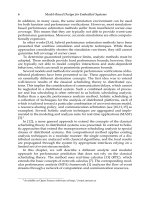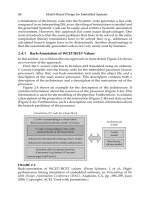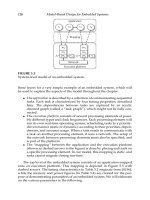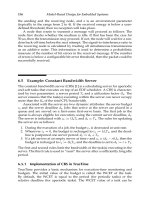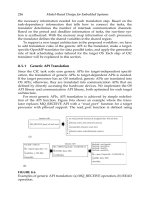Model-Based Design for Embedded Systems- P43 pptx
Bạn đang xem bản rút gọn của tài liệu. Xem và tải ngay bản đầy đủ của tài liệu tại đây (529.92 KB, 10 trang )
Nicolescu/Model-Based Design for Embedded Systems 67842_C013 Finals Page 386 2009-10-1
386 Model-Based Design for Embedded Systems
continuous systems. Timed and hybrid automata are attempts to bridge the
two worlds. Although timed automata are a special class of hybrid automata,
their study as a separate model is justified by the fact that many problems
that are very difficult or impossible to solve (i.e., undecidable) for hybrid
automata are easier or solvable for timed automata.
13.2.1 Timed Automata
Timed automata [9] extend finite automata by adding variables that are able
to measure real time: these variables are called “clocks.” Standard finite-state
automata are able to specify that a certain set of events occur in a specific
order; however, they do not typically specify how much time has elapsed
between two successive events. Figure 13.1a shows an example of a finite
automaton that specifies the order between four events a, b,c, d: event a pre-
cedes b, which precedes c, which precedes d. This automaton has five states
numbered 0–4, and four transitions labeled by the four events. State 0 is the
initial state.
Figure 13.1b shows an example of a timed automaton (TA). It is very
similar to the “untimed” version, but its transitions are annotated with addi-
tional information, referring to clocks x and y. This TA specifies, in addi-
tion to the order a, b, c,d between events, two timing constraints: (1) the time
that may elapse between a and d is at most 5 time units; (2) the time that
may elapse between b and c is at least 2 time units. In other words, we can
view the semantics of this automaton as a set of “all possible” sequences
of occurrences of events in time (“timed sequences”) that satisfy timing con-
straints (1) and (2) in addition to the correct order a,b, c,d. This is illustrated in
Figure 13.2.
We can also look at the semantics of this automaton in an “operational”
way. This is illustrated in Figure 13.3. The automaton starts at state 0 and
spends a certain amount of time t
0
there. During this time the value of each
clock of the automaton increases by the amount of time that has elapsed,
0123
4
abcd
(a)
x := 0 y := 0 y≥2 x≤5
0123
4
a
bcd
(b)
FIGURE 13.1
(a) A finite-state automaton. (b) A timed automaton.
Nicolescu/Model-Based Design for Embedded Systems 67842_C013 Finals Page 387 2009-10-1
Modeling, Verification, and Testing Using Timed and Hybrid Automata 387
Timing constraints
≥2
≤5a
b
d
c
Time
Two possible timed sequences
b
Time
1
6
Time
dca
b dca
2
5.54.5
1.5
3.5
1
FIGURE 13.2
Behaviors of TA of Figure 13.1.
0
1
2
3
4
State
Time
b
c
d
a
≥2
≤5
t
0
t
0
+ t
1
FIGURE 13.3
Operational semantics of TA of Figure 13.1.
that is, t
0
in this case. The automaton then “jumps” to state 1: event a occurs
in this jump, which is instantaneous. The automaton proceeds in the same
pattern: it spends some time t
1
in state 1, then jumps to state 2, and so on.
The automaton alternates between these “timed” and “discrete transitions.”
During a discrete transition, some clocks may be reset to zero, denoted by
x := 0, y := 0, and so on. Discrete transitions may have “guards,” that is,
conditions such as y ≥ 2orx ≤ 5, that must be satisfied in order for the
transition to be possible.
The operational view reveals that knowing what state the automaton
occupies at a given point in time (numbered 0, 1, 2, , in the earlier examples)
is not enough to predict its future behavior: one must also know the values
of its clocks (e.g., in order to check whether the guards are satisfied). This
is why we must distinguish between the “discrete” state of the automaton
(also called sometimes “control state” or “location”) and its “full” state that
includes the clock values (sometimes called “configuration” and sometimes
simply the “state”).
We will use state vs. configuration to distinguish the two.
Notice that the unit of time, although it is assumed to be the same for all
the clocks, is not explicit in a TA model. This is often an advantage, especially
when we are only interested in the relative magnitude of timing constraints
and not their absolute value. In the Alur–Dill model of timed automata, time
Nicolescu/Model-Based Design for Embedded Systems 67842_C013 Finals Page 388 2009-10-1
388 Model-Based Design for Embedded Systems
is “dense”: delays can be taken to be positive real or rational numbers. This
model is strictly more expressive than a discrete-time model, where delays
are the integer multiples of some given quantum of time. For instance, the
dense-time model can express that two events a and b can occur arbitrarily
close to each other, but not at the same time, using a “strict” constraint of the
form x > 0. Whether to opt for a dense or discrete TA model depends on
the application at hand. Considerations need to take into account not only
modeling requirements, but also the complexity of the algorithmic analysis,
such as model checking. Dense-time model-checking is more expensive than
discrete-time model-checking in theory, and often
∗
in practice as well [24].
The discrete- vs. dense-time debate is a nontrivial topic. In-depth studies can
be found in [19,48,81].
The basic model of timed automata described earlier can be extended in
various ways (one is by adding more powerful continuous dynamics, which
leads to hybrid automata described in Section 13.2.2). Discrete variables can
be added to the model, with basic types such as booleans or integers, but also
more complex types such as records, queues, and so on. These extensions are
very handy when modeling other than very simple examples. As long as the
domain of such variables can be restricted to be finite, these extensions do
not add to the expressive power of the model, since they can be encoded in
the state of the automaton. Note that things become more complicated when
attempting to relate such variables to clocks, for instance, resetting a clock x
to the value of a variable i,asinx := i, or comparing a clock to a variable
in a guard, as in x ≤ i. Some of these extensions can be handled, but others
may strictly increase the power of the model, leading even to undecidability.
Again this is a nontrivial topic, and the reader is referred to [3,23].
Another interesting extension is modeling “urgency.” To motivate this
concept, consider the example shown in Figure 13.1b. If the automaton stays
in state 2 more than 5 time units, then it can no longer reach state 4. We
may want to disallow this behavior, thus, model the assumption that state
4 “will” be reached. We can do this by adding acceptance conditions to the
automaton (e.g., making state 4 accepting and the others nonaccepting). But a
more convenient way is to state this using clock constraints. For instance, we
can impose the constraint x ≤ 5 at “states” 1, 2, and 3, expressing the fact that
the amount of time spent in those states must be such that this constraint is
not violated. This is one way of modeling urgency, and these state-associated
clock constraints are called “invariants” [49]. Another, more elaborate way is
to use “deadlines,” associated with transitions [18,93].
Even for relatively simple systems, modeling the entire system as a
single automaton can be very tedious. A solution is to build a model by
∗
But not always, as sometimes “symbolic” dense-time model-checking tools can represent
timing constraints more effectively than “enumerative” discrete-time methods. For instance, if
a guard involves large constants such as x ≤ 10
6
then a brute-force discrete-time enumeration
method with time step 1 may need to represent 10
6
distinct states while a symbolic method can
represent an infinite set of states with the symbolic constraint x ≤ 10
6
.
Nicolescu/Model-Based Design for Embedded Systems 67842_C013 Finals Page 389 2009-10-1
Modeling, Verification, and Testing Using Timed and Hybrid Automata 389
composing other models. In the case of timed automata, the different variants
of compositions have been proposed, where the components can communi-
cate through the “rendez-vous” type of action synchronization, FIFO queues,
shared variables, and so on. A common assumption in most of these com-
position frameworks is that the clocks of all automata measure exactly the
same time, in other words, that they are perfectly synchronized. This is obvi-
ously unrealistic when these clocks model real clocks. Unfortunately, mod-
eling phenomena such as clock drift explicitly (e.g., by defining the rate
of a clock x to be 1 ± for a fixed > 0) yields an undecidable model,
in general. As an alternative, some researchers studied an asymptotic ver-
sion of the problem where can be arbitrarily small [88,109]. This allows to
regain decidability while providing a more “robust” semantics. The issue
of robustness is especially important when the TA model is to be imple-
mented, for instance, as an embedded controller. However, the problem
can also be tackled with standard semantics, using appropriate modeling
techniques [2].
Regarding applications, it is fair to say that timed automata have not
found as widespread usage as standard, “untimed” models. This is not sur-
prising, given the fact that TA are a more specialized model in the sense
that often a discrete-time model is sufficient and this can be captured in
a more standard language (e.g., see [24]). Moreover, TA are more expen-
sive to analyze than “untimed” models. Still, timed automata are appealing
because of their “declarative” style of specifying timing constraints, that is
suitable for capturing high-level models and specifications.
∗
TA have been
used to model small- to medium-size systems, such as communication pro-
tocols, digital circuits, real-time scheduling systems, robotic controllers, and
so on. Up-to-date lists of case studies can be found at the web-sites of timed-
automata model-checking tools such as Kronos
†
and Uppaal
‡
as well as in
the publications of the authors of these tools.
13.2.2 Hybrid Automata
Hybrid automata [5] can be seen as an extension of timed automata with
more general dynamics. A clock c is a continuous variable with time deriva-
tive equal to 1, that is
˙
c(t) = 1. In a hybrid automaton, the continuous vari-
ables x can evolve according to some more general differential equations,
for example
˙
x = f(x). This allows hybrid automata to capture not only the
evolution of time but also the evolution of a wide range of physical entities.
∗
It is perhaps for this reason that some of the concepts in the timed automata model have
found their way into the MARTE (modeling and analysis of real-time and embedded systems)
profile for UML2. See />†
See and g.
fr/tripakis/openkronos.html.
‡
See .
Nicolescu/Model-Based Design for Embedded Systems 67842_C013 Finals Page 390 2009-10-1
390 Model-Based Design for Embedded Systems
The discrete dynamics of hybrid automata can also be more complex and
described with more general constraints.
In the following, we present a commonly used version of hybrid
automata. The different forms of constraints result in the different variants
of this model. A hybrid automaton A consists of a finite set Q of discrete
states and a set of n continuous variables evolving in a continuous state space
X ⊆ R
n
. In each discrete state q ∈ Q, the evolution of the continuous vari-
ables are governed by a differential equation:
˙
x(t) = f
q
(x(t), u(t)) where u(·) ∈
U
q
is an admissible input function of the form u : R
+
→ U
q
⊂ R
m
. This input
can be used to model some external disturbance or underspecified control. A
thermostat is a typical system that can be described by a hybrid automaton.
The room temperature x evolves according to
˙
x(t) =−x(t) +u(t) +v(t) when
the thermostat is on, and according to
˙
x(t) =−x(t) +v(t) when the thermo-
stat is off. The input v is a disturbance input modeling the influence of the
outside temperature and u is a control input modeling the heating power.
The invariant of a discrete state q is defined as a subset I
q
of X. The system
can stay at q if x ∈ I
q
. The conditions for switching between discrete states are
specified by a set of guards such that for each discrete transition e = (q, q
),
the guard set G
e
⊆ I
q
. Each transition e = (q, q
) is additionally associated
with a reset map R
e
: G
e
→ 2
I
q
that defines how the continuous variables x
may change when A switches from q to q
. For example, a nondeterministic
linear reset map can be defined as follows: for each x ∈ G
e
the new continuous
state x
= Rx +ε where R is a n ×n matrix and ε ∈ P ⊆ X.ThesetP models
the uncertainty of this reset map.
The functions f
q
are often assumed to be Lipschitz continuous and the
admissible input functions u(·) piecewise continuous. This ensures the exis-
tence and the uniqueness of solutions of the differential equations of each dis-
crete state. However, because of complicated interactions between the con-
tinuous and discrete dynamics, further conditions are needed to guarantee
the existence of a global solution of a hybrid automaton [74].
A state (q, x) of A can change in two ways as follows: (1) by a “continuous
evolution,” the continuous state x evolves according to the dynamics f
q
while
the discrete state q remains constant; (2) by a “discrete evolution,” x satisfies
the guard of an outgoing transition, the system changes discrete state by tak-
ing this transition and possibly changing the values of x according to the
associated reset map.
Figure 13.4 sketches a hybrid automaton with two discrete states q
1
and
q
2
and the continuous state space X is a 2-dimensional bounding rectangle.
The invariant I
1
of q
1
is the upper part of the rectangle limited by the bold
line, and the invariant I
2
of q
2
is the rectangle limited by the dashed line.
Figure 13.4 also shows a trajectory starting from a hybrid state (q, x
1
), which
first follows the dynamics f
1
under some input u(·). Under different inputs,
the system generates different trajectories
∗
(such as, the dotted curves in this
∗
We use the term “trajectory” instead of “execution” to give a geometric intuition.
Nicolescu/Model-Based Design for Embedded Systems 67842_C013 Finals Page 391 2009-10-1
Modeling, Verification, and Testing Using Timed and Hybrid Automata 391
x Є
12
x :=
12
(x)
x = f
1
(x, u)
.
.
x Є I
1
x = f
2
(x, u)
x Є I
2
x Є
21
x :=
21
(x)
x
2
x
3
x
1
I
1
x
4
x
5
I
2
FIGURE 13.4
A hybrid automaton and its trajectories.
Figure 13.4). The infiniteness of the input space results in an infinite number
of trajectories starting from the same state, which forms a dense set, often
called a “reach tube” [66].
When this trajectory reaches the guard set G
12
(which is the band between
the bold and the dotted line), the transition from q
1
to q
2
is enabled. At this
point, the invariant condition of q
1
is still satisfied and the system can either
switch to q
2
or continue with the dynamics of q
1
. The former is the case of
this example. The system “decides” to switch to q
2
when it reaches point x
2
.
The reset R
12
is the identity function and thus the trajectory starts following
the dynamics f
2
from the same point x
2
. When the trajectory reaches a point
x
3
in the guard G
21
(which is the dashed boundary of I
2
), it switches back to
q
1
and the application of the reset R
21
to x
3
results in a new state x
4
,from
which the system evolves again under the dynamics f
1
.
As illustrated with this example, it is important to note that this model
allows to capture “non-determinism” in both continuous and discrete
dynamics. This nondeterminism is useful for describing disturbances from
the environment as well as for taking into account the imprecision in model-
ing and implementation.
13.3 Exhaustive Verification
We use the term “exhaustive verification” to signify an automated proof
that a certain model satisfies a certain property. This problem is also called
“model checking.” Since what we want is a proof, if we succeed in obtaining
it, we can be certain that the model indeed satisfies the property. We con-
trast this to “partial verification” methods that are discussed in the following
section.
Nicolescu/Model-Based Design for Embedded Systems 67842_C013 Finals Page 392 2009-10-1
392 Model-Based Design for Embedded Systems
In this section, we review exhaustive verification for timed and hybrid
automata. The problem is decidable (but expensive) for timed automata and
undecidable for hybrid automata in general. In what follows we survey basic
methods to tackle the problem for the two models.
13.3.1 Model Checking for Timed Automata
The model checking problem for timed automata can be stated as: given a TA
(or a set of communicating timed automata) A, and given a property P, check
whether A satisfies P. We will briefly review in this section some methods
to answer this question for different types of properties P. This is an exten-
sively studied topic for which tutorials and surveys are already available (for
instance, see [3]). For this reason, we will only sketch the basic ideas and refer
to the literature for an in-depth study.
The simplest type of property P is “reachability”: we want to know
whether a given state (or configuration) s of the automaton is “reachable,”
that is, whether there exists an execution starting at some initial state (or a
set of possible initial states) and reaching s. Consider again the TA shown in
Figure 13.1b. Is state 4 reachable? It is, and Figure 13.3 presents an example
execution that reaches state 4. Suppose, however, that we replaced the con-
dition y ≥ 2 in this automaton by y > 5. In that case, state 4 would become
unreachable as can be verified by the reader.
Reachability is not only the simplest, but also the most useful type of
property. “Safety” properties (those that state that the system has no “bad”
behaviors, informally speaking) can be reduced to reachability with the help
of a “monitor.” A monitor for a given property is a “passive” component
that observes the behavior of the system and checks whether the property
is satisfied. If the property is violated then the monitor enters a designated
“bad” state. Checking whether the system satisfies the property can then be
reduced to checking whether the “bad” state of the monitor is reachable in
the composition of the system and the monitor.
“bad”
z := 0
Any
3
a
Else
b
01
2
z≤10
z>10
FIGURE 13.5
A TA monitor for checking a bounded-response property.
Nicolescu/Model-Based Design for Embedded Systems 67842_C013 Finals Page 393 2009-10-1
Modeling, Verification, and Testing Using Timed and Hybrid Automata 393
An example illustrating monitors is shown in Figure 13.5. Figure 13.5
shows a monitor for the property “a is always followed by b within at most
10 time units.” Notice that the monitor tries to capture the violation of the
property, that is, its negation. In particular, the monitor synchronizes with
the system on common labels. The label “any” in the self-loop transition at
state 0 of the monitor is a short-hand for “any label of the system”: notice
that this includes the label a, that is, the monitor is nondeterministic. This is
essential, because the monitor should check that the property holds on any
execution and every occurrence of a. After picking an a at random, the mon-
itor keeps track of the time using its (local) clock z.Ifb is observed no later
than 10 time units after a, the monitor moves to the “pass” state 2. Otherwise,
the monitor can move to the “bad” state 3: if the monitor is able to reach this
state, then the property is violated. The “else” label stands in this case for
“any label except b.”
How to check reachability for timed automata? In the case of a discrete-
time semantics, the problem can be reduced to a problem of checking reach-
ability for a discrete state-transition system: configurations can be seen as
vectors of nonnegative integers, where the first element of the vector corre-
sponds to the state and the rest to the values of the clocks.
∗
Moreover, the
system can be “abstracted” into a finite-state system by ceasing to increment
clocks whose value exceeds a certain constant c
max
: this is the greatest con-
stant with which a clock is compared in the automaton. For instance, in the
example of Figure 13.1b, c
max
= 5. When a clock’s value exceeds c
max
we
only need to “remember” this fact, and not the precise value of the clock,
since this does not influence the satisfaction of a timing constraint. With this
observation, one is left with the task of verifying exhaustively a finite-state
system. A vast number of methods exist for fulfilling this task.
The aforementioned reduction does not generally apply to timed
automata with dense-time semantics. Since the model is inherently infinite-
state, the decidability of the reachability problem is far from obvious. The
difficulty has been overcome by Alur and Dill using an elegant technique:
the “region graph” abstraction [9]. The idea is to partition the infinite space
of clock values (and consequently, the infinite space of configurations) into
a finite set of “regions” so that two configurations that belong to the same
region are equivalent in terms of their possible future behaviors. The set of
regions is carefully constructed so that clock vectors are in the same region
iff they satisfy the same constraints and will continue to do so despite time
elapsing or some of the clocks being reset.
Regions are illustrated in Figure 13.6. Figure 13.6 shows the partitioning
into the regions of the space of two clocks. Roughly speaking, every (x,y)
point where x and y assume integer values not greater than 2 is a region:
for example, the point (x = 1, y = 1) is a region and so is (x = 1, y = 0).
∗
We can always normalize the constants appearing in the timing constraints of the automa-
ton so that the time quantum is 1. Then clocks assume integer values.
Nicolescu/Model-Based Design for Embedded Systems 67842_C013 Finals Page 394 2009-10-1
394 Model-Based Design for Embedded Systems
1≤y− x≤2
2
1
y
x
x20
(a) (b)
1
201
2
1
y
1≤x≤2 0≤y≤1
FIGURE 13.6
A partition of the space of two clocks x and y into 78 regions (a); two
zones (b).
Moreover, open straight line segments such as x = 0 ∧0 < y < 1or1< x <
2 ∧x = y are regions. Open triangles such as 1 < x < 2 ∧ 0 < y < 1 ∧ x < y
are also regions. Finally, unbounded sets such as 1 < y − x < 2 ∧ x > 2are
also regions. For an exact definition of regions, the reader is referred to [3].
To keep the number of regions bounded, the same idea as the one described
earlier in the case of discrete-time is used, namely, abstracting the values of
clocks that exceed some maximal constant c
max
. In Figure 13.6, c
max
is taken
to be 2.
Using the concept of regions, a (dense) TA can again be seen as a finite-
state automaton: its states are pairs of discrete (control) states and regions.
However, although the region graph is an invaluable tool for proving decid-
ability, it is not very useful in practice. The reason is that the partition into
regions is too “fine-grained,” resulting in a huge number of regions (expo-
nential in the worst case in both the number of the clocks and the size of the
constants used in the timing constraints). Keeping in mind that the size of the
discrete state space (excluding the clocks) is often already very large, timed
automata suffer from what can be called a “double” “state-explosion” prob-
lem. Much of the research in the timed-automata community has attempted
to overcome this problem by finding more efficient verification methods.
Some of these attempts are described in the following text. It is fair to say
that no “silver bullet” has been found to the problem, and TA model check-
ing is still more expensive in practice than “untimed” model checking (which
is consistent with the worst-case theoretical complexity of the problem). This
is still an active area of research.
One of the ideas was to find partitions that are coarser than the region
graph. This led to the ideas of “time-abstract quotient” [4,106,110] and “zone
graph” [16,22,33,35,70,105]. The time-abstract quotient of a TA can be seen
as a coarse region graph, which still has the same properties. It is obtained
by “splitting” sets of configurations depending on their successors, using
a classic partition-refinement method [82]. In practice, the refined sets are
Nicolescu/Model-Based Design for Embedded Systems 67842_C013 Finals Page 395 2009-10-1
Modeling, Verification, and Testing Using Timed and Hybrid Automata 395
much coarser than regions (i.e., they are unions of many regions) although
in the worst case they can be as fine as individual regions. The zone graph
is based on representing sets of configurations as convex polyhedra called
“zones.” A zone can be seen as a conjunction of simple linear constraints on
clocks, for instance, 1 ≤ x ≤ 2 ∧ 0 ≤ y ≤ 1. Examples of zones over two
clocks x and y are shown in Figure 13.6 (zones are depicted in thick lines).
The zone graph is built by computing all successor zones of a given initial
zone in a “forward” manner. Zones may “overlap,” so in theory the zone
graph can be exponentially larger than the region graph. In practice, how-
ever, this does not happen. In fact the zone graph is considerably smaller,
and remains to this day the most efficient method of model-checking timed
automata.
Both the time-abstract quotient and the zone-graph methods raise a
number of interesting problems that have to do with the “symbolic” rep-
resentation of sets of configurations. Dill [35] proposed an efficient method
to represent zones as matrices of size n ×n, where n is the number of clocks.
These are called “difference bound matrices” or DBMs. DBMs are used in
implementations of the time-abstract quotient as well as the zone graph
methods. For the former, care must be taken to ensure that partition refine-
ment yields only convex sets of configurations, that is, zones, so that DBMs
can be used [106]. In the case of the zone graph, care must be taken to ensure
that the graph remains finite, and a set of abstractions have been developed
for this purpose [22,34,105].
Reachability covers many of the properties that one usually wishes to
check on a model, but not all. In particular, “liveness” properties (those that
state, informally speaking, that the system indeed exhibits “good” behaviors)
cannot be reduced to reachability. One way to model such properties is by
means of “timed Büchi automata” (TBA). TBA are the timed version of Büchi
automata: the latter define the sets of infinite behaviors (rather than sets of
finite behaviors, defined by standard finite automata). TBA often arise when
composing a (network of) plain TA with a monitor of a liveness property: the
monitor is often modeled as an “untimed” Büchi automaton; however, the
composition of the TA model and the monitor yields an automaton which is
both timed and Büchi. Let us provide an example.
A typical example of a liveness property is the “unbounded response
property” “a is always followed by b.” Notice that this is the “unbounded”
version of the property modeled by the monitor of Figure 13.5. It is
“unbounded” in the sense that it does not specify how much later b must
occur after a. It only requires that b occurs “some” time after a has occurred.
In order to check this property, we will again build a monitor that attempts
to capture the violation of the property. This monitor is the (untimed) Büchi
automaton shown in Figure 13.7. The monitor nondeterministically chooses
to monitor an event a, moving from state 0 to state 1. If a b never occurs, the
monitor has an infinite execution where it remains at accepting state 1: this
is an accepting execution, meaning the property is violated. If b is received,

